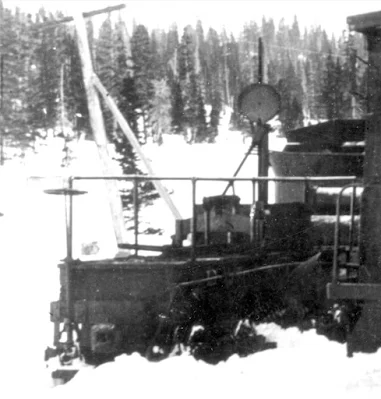Wednesday, May 3, 2023
The Chalk Creek Toboggan - Part 7
"One day this week the flanger, being used by the C&S to clear the rails of ice and snow, became detached from the train, owing to a defective coupling, at the St.Elmo water tank and started off down grade. The car kept to the rails for about 2 miles and is estimated to have gained a speed of at least 75 miles (ph). On a sharp curve, it jumped the track and plunged into the bank, completely clearing the right of way and did not injure the track one bit." - Chaffee County Republican, 5 February 1916
This would have been flanger 016 which was permanently assigned to the Buena Vista Romley run. The C&S had 4 narrow gauge flangers; 013 - 016. They were very heavy cars. By comparison the heaviest n.g. freight cars were 6 big reefers built in 1898. They weighed nearly 31,000lbs but they were also 30' long. The flangers were 17' over the end sills and weighed 18,300lbs. Considering their purpose and shortness they had to be heavy.
 |
| C&Sng 016 O scale model of the Chalk Creek Toboggan - Pool |
 |
| Likely 013 Note toolbox - round targets. Como late '20s |
The weight of 016 and speed it may have reached leaves little doubt that the main was "cleared" of ice and snow. That it stayed on track for two miles may be phenomenal but being such a heavy weight maybe not so much. In recollection of another version of the "Chalk Creek Toboggan" story (which I have yet to find again) the car never derailed and coasted to a stop along the relatively level stretch between Mt. Princeton and Nathrop. That does sound more like a wood-stove yarn as there were plenty of severe curves along perhaps 15 miles. The printed record is certainly believable.
 |
| 08 would become 014 by September 1909 - Scott |
The St. Elmo water station (an unusually small tank of just 8'x14') was almost 1600 feet down grade from the St. Elmo depot but 4 miles above the Fisher (Alpine) depot.The flanger left the track well before it could whistle past - or into - that station.
Flangers on South
Park trains were often placed behind the lead engine. This practice
seems to have been problematic as several wrecks were blamed upon them.
The more practical location was to put it ahead of the lead engine which
must have been the case in this instance; lest it not be able to
escape. Photos of 016 ahead of the engine are shown in several pictorial
volumes.
 |
| 013 without plow for idler service by April '36 - Kelly |
Very likely, in the 30 plus years the railroad had been using such cars, this wasn't the first time a flanger got away. This is simply the only time I am aware of that such an event was recorded. It is an interesting part of this car's story and historical account.
 |
| 02 or 03 (1890 Snow Plow trials) round targets no tool box |
The 2 builds were very similar and photographically there were only a few detail differences. All of the cars were built when the South Park was under Union Pacific control and new cars were equipped with what we call the Type B swing beam truck. Except for 015, all of the cars appeared with these trucks. But by 1936 there was a surplus of modern trucks as hundreds of type 1 coal and flat cars were being scrapped. The Leadville car, 015, appears in 1936 with a set of the ASF 4' archbar trucks from the scrapped cars.
The two 1887 cars seem to have had round targets; indicators to the engine crew when the ice blades were engaged. An air cylinder controlled by the cab would raise the blade when passing thru switches and other possible obstructions. The 1885 cars had rectangular targets. Also, both 013 and 014 seem to have had the front end tool box at one time or another but the box has never been seen on an identifiable 1885 car.
 |
| The last Flanger, late 1930s, Leadville - Kelly |
By 1911, 014 was off the roster. Some time between 1934 and early 1936, 013 was stripped of her blades and used as an idler car for moving mixed gauge cars together. It was retired in 1936 but was reinstated in 1940 for use on the Leadville Climax run. The Leadville Mineral Belt consisted of many miles of dual gauge track. By 1938 this was the only portion of the narrow gauge left after the majority of the South Park system had been abandoned and removed in 1937. Then in 1942 the run was completely standard gauged and the two flangers were disposed of by 1943.
 |
| 015 & 016 had no box. Rectangular targets, 4-'36 - Kelly |
By 1911, 014 was off the roster. Some time between 1934 and early 1936, 013 was stripped of her blades and used as an idler car for moving mixed gauge cars together. It was retired in 1936 but was reinstated in 1940 for use on the Leadville Climax run. The Leadville Mineral Belt consisted of many miles of dual gauge track. By 1938 this was the only portion of the narrow gauge left after the majority of the South Park system had been abandoned and removed in 1937. Then in 1942 the run was completely standard gauged and the two flangers were disposed of by 1943.











No comments:
Post a Comment